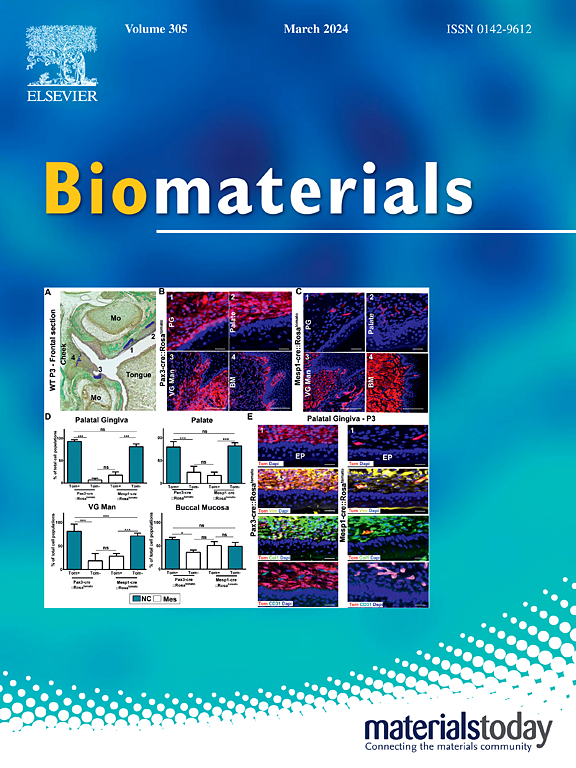Hierarchical interconnected porous scaffolds with regulated interfacial nanotopography exhibit antimicrobial, alleviate inflammation, neovascularization, and tissue integration for bone regeneration
IF 12.8
1区 医学
Q1 ENGINEERING, BIOMEDICAL
引用次数: 0
Abstract
Novel interconnected porous scaffolds featuring suitable micro-interface structures hold significance in bone regeneration. Therefore, a hierarchical interconnected porous scaffold with nanotopography interface of pores, mimicking natural bone structure and extracellular matrix microenvironment, are designed to enhance bone regeneration by improving cell adhesion, proliferation, alleviate inflammation, and tissue integration capabilities. The scaffold is fabricated through Pickering emulsion templating method, with aminated gelatin and copper-hydroxyapatite nanoparticles serving as co-stabilizers. This process results in a dual nanoparticles-decorated interface, which could provide ample anchoring points for cells. Adjusting the ratio of the two nanoparticles leads to scaffold with different interfacial roughness. The resultant scaffold increases the number of cellular focal adhesions, enhancing cell adhesion, while its high porosity supports cell recruitment, proliferation and immunomodulation. Copper-hydroxyapatite adsorption at the pore interface reduces copper ion usage and exposes nanoparticles for direct cell contact, endowing the scaffold with enhanced antibacterial and angiogenic properties. An initial burst release phase of copper ions exerts inhibitory effects on mRNA expression, followed by a sustained and optimal release phase that promotes osteogenesis. The molecular mechanism underlying the scaffold of osteogenic potential has been elucidated through RNA sequencing analysis, along with the regulation of inflammatory cytokine expression. In vitro and in vivo studies alike verify its neovascularization-promoting capacity. The efficacy shown in a rat model with critical cranial defects underscores its clinical promise for bone regeneration, as Cu-doped scaffolds retain osteoinductive qualities after 10 weeks in vivo. This study innovates a manufacturing method for a novel scaffold in bone tissue engineering.
求助全文
约1分钟内获得全文
求助全文
来源期刊

Biomaterials
工程技术-材料科学:生物材料
CiteScore
26.00
自引率
2.90%
发文量
565
审稿时长
46 days
期刊介绍:
Biomaterials is an international journal covering the science and clinical application of biomaterials. A biomaterial is now defined as a substance that has been engineered to take a form which, alone or as part of a complex system, is used to direct, by control of interactions with components of living systems, the course of any therapeutic or diagnostic procedure. It is the aim of the journal to provide a peer-reviewed forum for the publication of original papers and authoritative review and opinion papers dealing with the most important issues facing the use of biomaterials in clinical practice. The scope of the journal covers the wide range of physical, biological and chemical sciences that underpin the design of biomaterials and the clinical disciplines in which they are used. These sciences include polymer synthesis and characterization, drug and gene vector design, the biology of the host response, immunology and toxicology and self assembly at the nanoscale. Clinical applications include the therapies of medical technology and regenerative medicine in all clinical disciplines, and diagnostic systems that reply on innovative contrast and sensing agents. The journal is relevant to areas such as cancer diagnosis and therapy, implantable devices, drug delivery systems, gene vectors, bionanotechnology and tissue engineering.
 求助内容:
求助内容: 应助结果提醒方式:
应助结果提醒方式:


